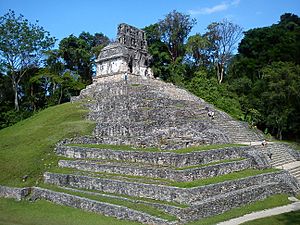Maya architecture facts for kids
Maya architecture is super old and amazing! It shows how smart the Maya peoples were for thousands of years, even before Europeans came to the Americas. The most famous Maya buildings are their giant step pyramids. These were built using ideas from other ancient American cultures.
The Maya used cool math and detailed carvings to build everything. From simple homes to fancy temples, they made it all! This article will focus on the most well-known Maya buildings from their early and classic times. Temples at places like Palenque, Tikal, and Uxmal are perfect examples of their incredible art and building skills. By looking at these buildings, we can learn a lot about Maya beliefs and their culture.
Contents
How Maya Cities Were Designed
Maya cities were built all over Mesoamerica, which has many different types of land. Because of this, their cities often grew in a bit of a messy way, fitting into the hills or flat plains. Maya builders really liked to use natural features. For example, cities on flat limestone land in the northern Yucatán Peninsula spread out a lot. But cities in the hills of Usumacinta used the natural height of the land to make their towers and temples look even taller!
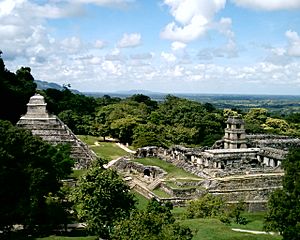
Even though they seemed to grow randomly, Maya cities still had some order. When they started building big, they usually picked a main direction, like north or east. Cities grew by connecting large open areas called plazas with platforms. These platforms were the base for almost all Maya buildings. They used special raised roads called sacbeob to connect different parts of the city. This was different from cities like Teotihuacán, which were built in a strict grid pattern.
The heart of a Maya city was its big plazas. Important government and religious buildings surrounded these plazas. This included royal palaces, huge pyramid temples, and sometimes even ballcourts. The Maya carefully planned the direction of their temples and observatories. They built them to match how they understood the stars moved.
Right outside this main area were buildings for less important nobles. There were also smaller temples and shrines. The common people lived in simpler homes further away from the city center.
In the Classic Era, Maya cities were mostly about dividing space with big monuments and roads. The open plazas were the main gathering spots. Later, in the Post-Classic era, Maya cities became more like forts. They had fewer large plazas, focusing more on defense. Smaller, protected towns appeared on places like peninsulas and islands.
How Maya Buildings Were Made
Most stone buildings in Maya cities sat on a platform. These platforms could be short, less than a meter, or very tall, up to 45 meters! Their height depended on how important the building was. Stone steps often went up one side of these platforms. This gave Maya buildings their common balanced look.
These platforms were usually made of cut stone and stucco. They were filled with tightly packed gravel. The carvings on the platforms often showed what the building was used for. Once the platforms were ready, the Maya built their grand homes and temples on these strong bases.
The Maya didn't focus much on how useful the inside of a building was. They cared more about how it looked from the outside. However, they often used a special type of arch called a corbelled arch. This arch looked a bit like the simple Maya huts. It wasn't great for making a lot of inside space. It needed thick stone walls to hold up the high ceiling. But some temples used many of these arches to create rooms called pibnal, which were like sweatbaths. An example is in the Temple of the Cross at Palenque.
After buildings were finished, the Maya often added detailed carvings to a layer of stucco. They also carved stone designs that were used on the outside of buildings. These carvings often went all around the building. They showed art related to the people who lived there or the building's purpose. In many Maya places, they also painted the stucco in bright colors.
The Maya didn't use standard measuring units. But their buildings were still perfectly proportioned using something like the golden mean. For their homes, they started with a square. Then they used a cord to measure from one corner to the opposite. By swinging the cord down, they found a new length for the base. This created a rectangle with special proportions found in nature. The Maya believed certain proportions had religious meaning. So, their way of measuring is called sacred geometry. The ancient Egyptians also used this method. The Maya played with different proportions to make balanced and beautiful designs without using actual units.
Some people thought that Maya temples and pyramids were rebuilt every 52 years, matching their calendar cycle. But it seems that rebuilding often happened when a new ruler came to power or for political reasons. However, building on top of old structures was very common. For example, the North Acropolis at Tikal shows about 1,500 years of changes!
Building Materials
The Maya used very simple tools to build their structures. Most tools were made of stone found nearby. Limestone was super important because it was common in most Maya settlements. Maya cities were often built where they could easily get the stones they needed. This meant most quarries were right outside the city. Palenque and Tikal had some of the best limestone quarries. Besides limestone, they also used sandstone from Quiriguá and volcanic rock from Copan.
The Maya also used a lot of mortar in their buildings. They made mortar by heating limestone to very high temperatures. This mortar was so widely used that the Maya even used it for sculptures, decorations, and floor layers. Their mortar was very strong and made buildings last a long time. But humid weather could sometimes damage it.
For important buildings, the Maya would cover the outside with stucco. Then they painted it with bright colors like red, yellow, green, and blue.
Cool Maya Buildings
Palaces
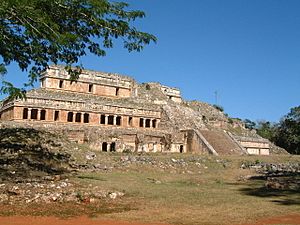
Maya palaces were large and often beautifully decorated. They were usually near the center of a city and were home to the most important people. A very large royal palace with many rooms on different levels might be called an acropolis. But often, palaces were one story with small rooms and at least one inner courtyard. These buildings were designed to be useful homes, but also fancy enough for their important residents.
Archaeologists believe that many palaces also contained tombs. At Copán, a very powerful city, a tomb for an ancient ruler was found under hundreds of years of later building. The North Acropolis at Tikal also seems to have been a burial site many times.
E-groups
"E-Group" is a name given by experts to certain groups of buildings found at many Maya sites. These groups usually have a stepped pyramid on the west side of a square plaza. On the east side of the plaza, there's a long, raised building. Sometimes, this building has three smaller temples on top of it. Often, two other smaller buildings are on the north and south sides of the plaza.
The main western pyramid usually has several levels and stairs on all four sides. But only the eastern stairs, facing the plaza, go to the top. These stairs have large railings that stick out from the pyramid. They were decorated with big stucco masks and carvings. In later E-groups, these four-sided stairs are not present.
E-group complexes are named after the first one found, Structure E-VII-sub at Uaxactun. An archaeologist named Frans Blom first identified them in 1924.
Some people thought these E-groups were observatories. This is because the one at Uaxactun seems to line up with the sunrises on the solstices and equinoxes. However, studies show that these alignments connect parts built at different times. So, they probably weren't used for actual observations. Also, other E-groups face different directions. Their main uses were for religious ceremonies and burials. So, calling them "observatories" might not be quite right. Other ideas suggest they tell a creation story through their art.
Triadic Groups
These groups of buildings have a raised platform, which could be a large acropolis or a steep pyramid. They have a grand stairway. A main building faces the stairs, and two other buildings face each other on either side of the platform. Some believe this design was meant to look like the Celestial Hearth (the Orion constellation). Others think it was a stage for special ceremonies where rulers were crowned. More recently, Triadic Groups have been seen as places to honor the Maize God's return. These complexes appeared in earlier Maya times and slowly became less common.
Pyramids and Temples
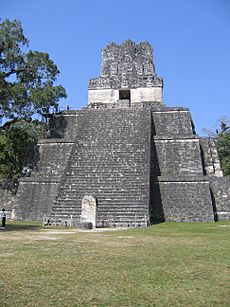
Often, the most important holy places were on top of tall Maya pyramids. Some were over two hundred feet high, like the one at El Mirador. The holy building on top usually had a tall crest or "roof comb." Recent discoveries show that pyramids were often used as tombs. But the temples on top rarely contained burials. Maya pyramids had flat tops, similar to Aztec pyramids.
At Chichén Itzá, there's a famous pyramid called El Castillo (meaning 'the castle'). It has four stairways, each with 91 steps. If you count the top platform, that's 365 steps, like the days in a year! Other parts of the pyramid also use numbers important in astronomy. This pyramid is a great example of how Maya myths and sky cycles were built into their architecture.
Ancient civilizations like the Egyptians believed there were powers in the sky that brought rain and kept storms away. They built pyramids to get closer to these powers. The Mesopotamians built similar stepped towers called ziggurats. The Maya and other Mesoamericans built their pyramids high above the forests to see the heavens. Besides honoring the gods, Maya pyramids also served as places to watch the sun. They even lined up with the main directions (north, east, west, south), like a compass!
This pyramid is also called the Pyramid of Kukulcán. It puts on an amazing show for thousands of visitors during the equinoxes. The setting sun's rays create a shadow that looks like a snake slithering down the northern stairs. The snake is made of many triangle shapes, making it look like a diamondback snake. At the bottom of the stairs, there are huge snake head sculptures, making the effect even more real. While many believe this light-and-shadow effect was made on purpose to mark the equinoxes, it's unlikely. The effect can be seen for several weeks around the equinoxes, so it couldn't pinpoint an exact date.
Maya architecture is very different from other cultures in Mesoamerica. You can see how myths and astronomical events are mixed into almost all Maya palaces or pyramids. You'll also notice a strong influence from the Toltecs at Chichén Itzá. The Toltecs came to the Maya area and blended their traditions around the year 1000.
Observatories
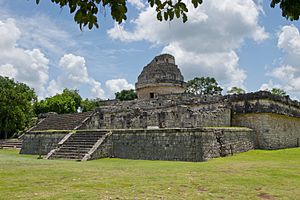
The Maya were excellent astronomers. They had mapped out the movements of the sun, Venus, and the Moon. Many temples have doorways and other features that line up with events in the sky. Round temples, often built for the god Kukulcan, are sometimes called "observatories" by tour guides today.
However, we now know that many different types of buildings were built to face specific sunrises and sunsets. The dates they lined up with were often important for farming seasons. They also matched periods in their calendar system. This suggests that these alignments helped the Maya plan their farming and religious activities. Even though many important Maya buildings were built with astronomy in mind, their main jobs were religious, residential, or administrative. So, calling any building just an "observatory" isn't always accurate.
Ballcourts
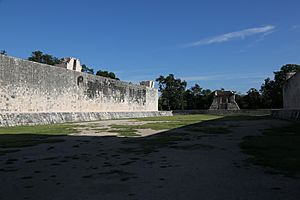
The ritual ballgame was a very important part of Mesoamerican life. So, courts for this game were built all over the Maya lands, often on a grand scale. Ballcourts had two long walls that made up the playing area. Earlier courts, like at Cobá, had sloped sides. Later ones, like at Chichén Itzá, had straight up-and-down sides. Often, the ends were closed off, making the court look like a capital "I" from above.
When the Maya played games in the Ballcourts, the ball was made of solid rubber and could be as big as a foot across. Teams on opposite ends of the court passed the ball. Players could only hit it with their knees or hips, a bit like soccer today. Points were scored if the other team couldn't return the ball correctly. In central Mexico and later in Yucatán, stone rings were set high up in the side walls of the court. It was a huge achievement for a player to hit the ball through one of these rings!
Cave Sites
Maya cave sites were also very important to the Maya people. These include places like Jolja Cave, Naj Tunich, the Candelaria Caves, and the Cave of the Witch. The Maya also had creation myths that involved caves. Some cave sites are still used by modern Maya people in the Chiapas highlands of Mexico. Some of these caves were even partly or fully man-made!
See also
 In Spanish: Arquitectura maya para niños
In Spanish: Arquitectura maya para niños


